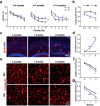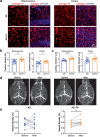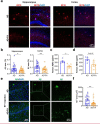Ferulic Acid Ameliorates Alzheimer's Disease-like Pathology and Repairs Cognitive Decline by Preventing Capillary Hypofunction in APP/PS1 Mice
- PMID: 33786807
- PMCID: PMC8423929
- DOI: 10.1007/s13311-021-01024-7
Ferulic Acid Ameliorates Alzheimer's Disease-like Pathology and Repairs Cognitive Decline by Preventing Capillary Hypofunction in APP/PS1 Mice
Abstract
Brain capillaries are crucial for cognitive functions by supplying oxygen and other nutrients to and removing metabolic wastes from the brain. Recent studies have demonstrated that constriction of brain capillaries is triggered by beta-amyloid (Aβ) oligomers via endothelin-1 (ET1)-mediated action on the ET1 receptor A (ETRA), potentially exacerbating Aβ plaque deposition, the primary pathophysiology of Alzheimer's disease (AD). However, direct evidence is still lacking whether changes in brain capillaries are causally involved in the pathophysiology of AD. Using APP/PS1 mouse model of AD (AD mice) relative to age-matched negative littermates, we identified that reductions of density and diameter of hippocampal capillaries occurred from 4 to 7 months old while Aβ plaque deposition and spatial memory deficit developed at 7 months old. Notably, the injection of ET1 into the hippocampus induced early Aβ plaque deposition at 5 months old in AD mice. Conversely, treatment of ferulic acid against the ETRA to counteract the ET1-mediated vasoconstriction for 30 days prevented reductions of density and diameter of hippocampal capillaries as well as ameliorated Aβ plaque deposition and spatial memory deficit at 7 months old in AD mice. Thus, these data suggest that reductions of density and diameter of hippocampal capillaries are crucial for initiating Aβ plaque deposition and spatial memory deficit at the early stages, implicating the development of new therapies for halting or curing memory decline in AD.
Keywords: APP/PS1 mouse; Alzheimer’s disease; Aβ plaque; Endothelin-1; Ferulic acid (FA); Hippocampus.
© 2021. The Author(s).
Conflict of interest statement
Some authors are listed as the inventors of a CN Patent (application no. 202010395578.7). The other authors declare that they have no competing interests.
Figures







Similar articles
-
Influenza vaccination in early Alzheimer's disease rescues amyloidosis and ameliorates cognitive deficits in APP/PS1 mice by inhibiting regulatory T cells.J Neuroinflammation. 2020 Feb 19;17(1):65. doi: 10.1186/s12974-020-01741-4. J Neuroinflammation. 2020. PMID: 32075657 Free PMC article.
-
Etomidate ameliorates Alzheimer-like neuropathology and cognitive impairment in APP/PS1 mice.J Physiol Pharmacol. 2025 Feb;76(1). doi: 10.26402/jpp.2025.1.04. Epub 2025 Mar 18. J Physiol Pharmacol. 2025. PMID: 40137847
-
p110δ PI3-Kinase Inhibition Perturbs APP and TNFα Trafficking, Reduces Plaque Burden, Dampens Neuroinflammation, and Prevents Cognitive Decline in an Alzheimer's Disease Mouse Model.J Neurosci. 2019 Oct 2;39(40):7976-7991. doi: 10.1523/JNEUROSCI.0674-19.2019. Epub 2019 Jul 30. J Neurosci. 2019. PMID: 31363064 Free PMC article.
-
Ferulic Acid in Animal Models of Alzheimer's Disease: A Systematic Review of Preclinical Studies.Cells. 2021 Oct 5;10(10):2653. doi: 10.3390/cells10102653. Cells. 2021. PMID: 34685633 Free PMC article.
-
Development of capillary dysfunction in Alzheimer's disease.Front Aging Neurosci. 2024 Aug 29;16:1458455. doi: 10.3389/fnagi.2024.1458455. eCollection 2024. Front Aging Neurosci. 2024. PMID: 39267722 Free PMC article. Review.
Cited by
-
Honey and Alzheimer's Disease-Current Understanding and Future Prospects.Antioxidants (Basel). 2023 Feb 9;12(2):427. doi: 10.3390/antiox12020427. Antioxidants (Basel). 2023. PMID: 36829985 Free PMC article. Review.
-
Ferulic Acid Improves Synaptic Plasticity and Cognitive Impairments by Alleviating the PP2B/DARPP-32/PP1 Axis-Mediated STEP Increase and Aβ Burden in Alzheimer's Disease.Neurotherapeutics. 2023 Jul;20(4):1081-1108. doi: 10.1007/s13311-023-01356-6. Epub 2023 Apr 20. Neurotherapeutics. 2023. PMID: 37079191 Free PMC article.
-
Ferulic Acid as an Anti-Inflammatory Agent: Insights into Molecular Mechanisms, Pharmacokinetics and Applications.Pharmaceuticals (Basel). 2025 Jun 18;18(6):912. doi: 10.3390/ph18060912. Pharmaceuticals (Basel). 2025. PMID: 40573306 Free PMC article. Review.
-
Brain regions differences in amyloid-β and gene expression in early APP/PS1 mice and identification of Npas4 as a key molecule in Alzheimer's disease.Biomol Biomed. 2024 Oct 17;24(6):1816-1826. doi: 10.17305/bb.2024.10820. Biomol Biomed. 2024. PMID: 38958450 Free PMC article.
-
Characterization of Orange Peel Extract and Its Potential Protective Effect against Aluminum Chloride-Induced Alzheimer's Disease.Pharmaceuticals (Basel). 2022 Dec 22;16(1):12. doi: 10.3390/ph16010012. Pharmaceuticals (Basel). 2022. PMID: 36678510 Free PMC article.
References
-
- Beyreuther K, Masters CL. Amyloid precursor protein (APP) and beta A4 amyloid in the etiology of Alzheimer’s disease: precursor-product relationships in the derangement of neuronal function. Brain pathology (Zurich, Switzerland). 1991;1(4):241–251. doi: 10.1111/j.1750-3639.1991.tb00667.x. - DOI - PubMed
Publication types
MeSH terms
Substances
LinkOut - more resources
Full Text Sources
Other Literature Sources
Medical
Molecular Biology Databases

